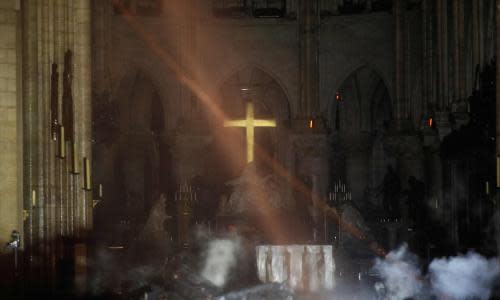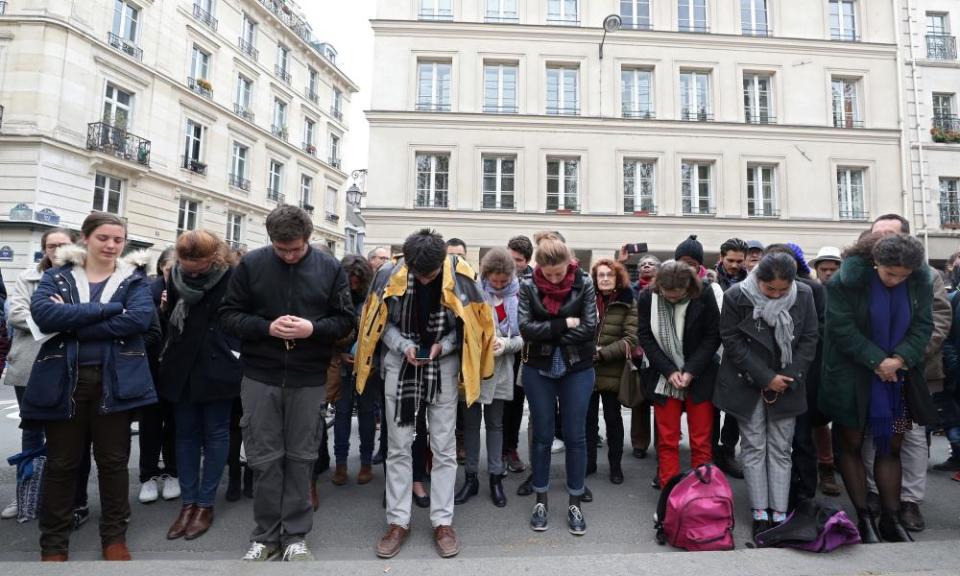'On our watch we let it burn': Notre Dame fire leaves hole in heart of Paris

Hours after the last flames had died down, Notre Dame stood defiant, charred and roofless in the daylight. The huge wooden doors were open as firefighters continued to secure the building, hinting at the dangers and weaknesses that may still lie within.
Related: Notre Dame Cathedral fire – a visual guide and timeline
Inside, beneath a gaping hole above the choir area where the burning spire had crashed down on Monday night, lay rubble, shards of glass, and twisted metal, but the altar and gleaming cross were still standing. “It felt like I was looking at a bombing,” said Philippe Marsset, the vicar general of Notre Dame, one of the first to enter to survey the damage.
The cathedral square, usually heaving with tourists brandishing selfie sticks, was cordoned off, eerily silent and deserted, its paving stones peppered with flecks of black ash.
On the edge of the River Seine, where the gothic architectural masterpiece sits proudly on an island, locals were still coming to terms with the fear and panic of the night before, when fire had raged across the roof, believed to have been started accidentally possibly as a result of building work.
From the moment the first flames became visible, hundreds had run down to the river shouting “Notre Dame is burning!” Then, for hours, stunned crowds looked on as flames soared into the sky and the spire and most of the roof gradually caved in.
Crowds sang church liturgies, many wept, some fell to their knees in grief, and most gasped and wailed at each loud crackle as the spire was engulfed in flames. In a city that has endured years of terrorist killings, waking to bloodstains on the street, there was relief that no one had been killed.
Some said they felt anger and a sense of shame. “Think of the all people who built it over centuries, and on our watch we let it burn,” said an older woman with a walking cane, wiping her eyes.

Firefighters tackle the blaze as the roof of Notre Dame burns.Photograph: Bastien Louvet/SIPA/Rex/Shutterstock
Paris was still in shock. “I came back this morning to check it wasn’t just a nightmare I’d wake up from,” said Paul Piron, a 23-year-old literature student. He had stood until midnight singing liturgies and Ave Marias as he watched the cathedral burn.
“We were terrified it would collapse completely,” he said. He had attended vespers there every Sunday for three years. “It’s not just stone, it’s a place of life, a parish.” It was devastating to think it could be years before people could return. “I think it will be another 10 years before I can go inside again,” he said.
How the Notre Dame fire spread
For Parisians, Notre Dame had seemed imperishable. Crusaders prayed there before leaving for holy wars, it had outlived the monarchs and the pillaging of the French Revolution. It hosted Napoleon Bonaparte’s coronation, survived wars and Nazi occupation, ringing its bells to mark the liberation of Paris. And once again, here it was still standing. But the missing roof and spire left a sorrowful gap against the white sky. “There’s something empty, missing,” said Eric Zelnick, 69, who lived in nearby Le Marais and had walked past it every day for decades. “It was the face of Paris, now it’s a face missing its teeth.”
In the French national psyche, Notre Dame was more than a historic house of God; it was a marker, a reference point, even in secular France. The most-visited monument in the capital, attracting 12 million tourists a year, it is a symbol of literature and history, and is France’s “zero kilometre” point from which all road distances are measured.
At more than 850 years old, its age had always served as a reminder that it could outlive all those who wandered past, in awe of its beauty.
“There’s something very deep that comes up in all of this – we’re just a little tiny part of the story of this building,” said Jean Cottin, 55, a film producer who had returned to see the damage after watching the spire fall on Monday night. “I always came here as a child, it was a place of imagination. Now I’m wondering if I’ll ever see it rebuilt in my lifetime. It makes you think about the passing of time: our lives are a blink of an eye in the lifetime of this building which has stood for so long.”
He said the charred structure had become a symbol of endurance. “It’s devastated yet it’s still standing – there’s a kind of strength that comes from that.”

People pray near Notre Dame.Photograph: Yves Herman/Reuters
Firefighters moved along the tops of the bell towers, checking for damage. The cathedral had gone from a shocking vision of towering orange flames rising into the clear blue sky early on Monday evening, to a damaged structure against a white sky of drizzle in the morning.
There was concern in the crowd: would we, in our modern era of technology, be up to rebuilding what skilled craftsmen and genius had defied all odds to create centuries ago?
Bertrand de Feydeau, from the preservation group Fondation du Patrimoine, said the wooden roof was built with beams from primal forests more than 800 years ago. “We don’t, at the moment, have trees on our territory of the size that were cut in the 13th century,” he said. So the roof may never be built exactly the same, it will always carry the mark of this era and will have to use modern technology.
Catherine, 80, from Brittany, a former nurse who had worshiped at Notre Dame, cycled there to contemplate the damage. “I’m optimistic that there was talk of rebuilding it before the fire had even gone out,” she said.
But she was aware of the long years ahead where it would have to be closed to the public. “I won’t be able to go back into it in my lifetime,” she sighed, as she parked her bike to stand and pray.

 Yahoo News
Yahoo News 